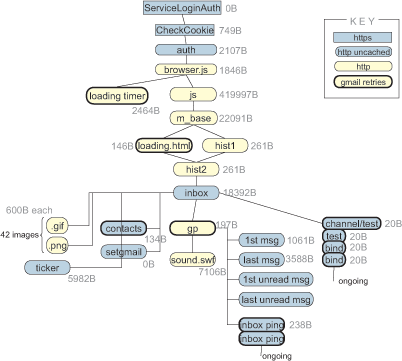Abstract.
Retrieving a web page involves a flurry of short messages between the browser and the web server; the user's experience of web browsing depends both on how this message exchange is structured, and on the characteristics of the network. Web sites are becoming more complex, and networked applications in general are becoming more elaborate, and the effect is to exacerbate the sensitivity to network characteristics. I will describe some first steps in modelling the performance of general distributed algorithms over unreliable networks, with the goal of finding better ways to design networked applications.
What happens when you log onto
gmail.com to check your
inbox? When I logged on on 28 August 2006 using Firefox 1.07, this is
the graph showing all the separate http requests and the dependencies
between them, and the content sizes.
To uncover the dependencies I used Paros
3.2.13 to trap each http request, and on successive visits I let
through different sets of requests, and I noted which requests ensued.
The graph has 66 items, and each level takes at least one round trip time. Firefox limits how many items can be requested simultaneously, and it uses different limits for http 1.0, http 1.1 or http 1.1 with pipelining. For each scheme we can calculate how long we expect it to take to retrieve the entire web page, and how this time depends on the network's round trip time and packet drop probability.